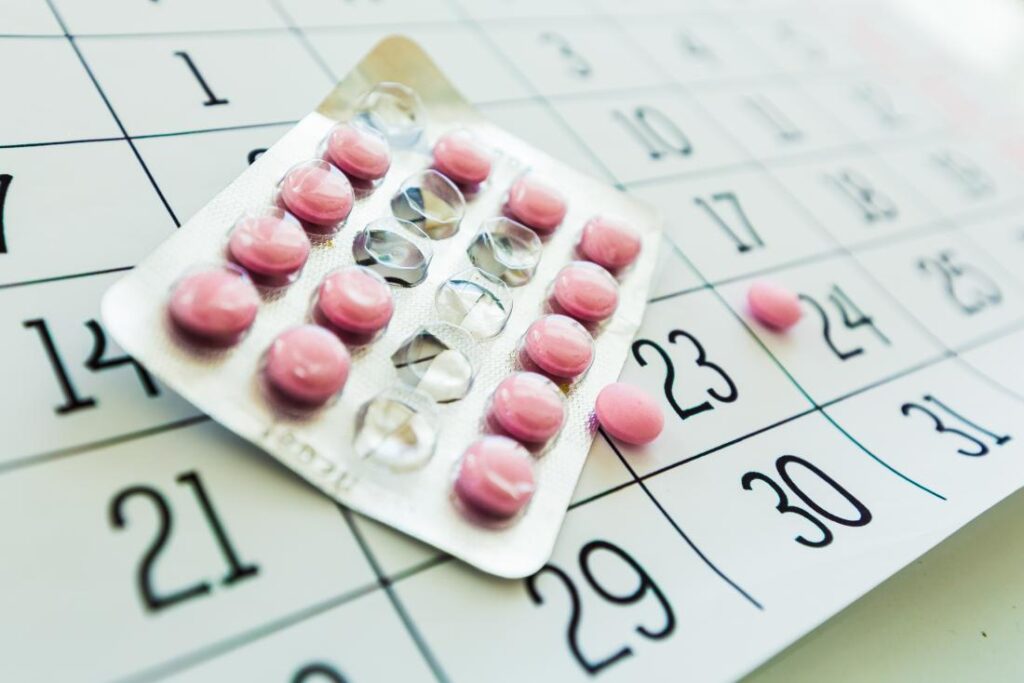The luteal phase is an important part of the menstrual cycle that occurs after ovulation and before your period begins. It plays a key role in hormone regulation and pregnancy preparation. But what happens to this phase when you’re on birth control?
Recommended: How to Choose a Birth Control Method Without Side Effects
Since most hormonal birth control methods prevent ovulation, many people wonder if they still experience a true luteal phase.
In this blog, we’ll explore how birth control affects your menstrual cycle, whether the luteal phase still occurs, and what changes you might notice while using contraceptives.
Understanding the Menstrual Cycle and the Luteal Phase
The menstrual cycle prepares the body for pregnancy and typically lasts 28 days, though it can vary. It consists of four phases: menstruation, follicular, ovulation, and luteal. The luteal phase occurs after ovulation and lasts about 10–16 days, primarily regulated by progesterone, which thickens the uterine lining in preparation for pregnancy. If fertilization doesn’t occur, progesterone levels drop, leading to menstruation. Many experience PMS symptoms like bloating, mood swings, and fatigue during this phase.

However, hormonal birth control prevents ovulation, meaning the natural luteal phase does not occur. Instead, steady hormone levels from birth control suppress ovulation, and users experience withdrawal bleeding rather than a true period when they stop taking active pills or use placebo pills.
Recommended: Family Planning for Women Over 30
How Birth Control Affects the Menstrual Cycle
Hormonal birth control, such as pills, patches, injections, and IUDs, works by altering the body’s natural hormone levels to prevent ovulation. Without ovulation, the menstrual cycle changes significantly. The usual rise and fall of estrogen and progesterone are replaced by consistent hormone levels, which prevent the thickening of the uterine lining and suppress the natural luteal phase.
Instead of a true period, birth control users experience withdrawal bleeding during placebo pill days or breaks between doses. This bleeding is lighter and more predictable than a normal period because the uterine lining remains thin. Some birth control methods, like continuous-use pills or hormonal IUDs, can even stop bleeding altogether.
Recommended: Budget-Friendly Family Planning Strategies
By controlling hormone fluctuations, birth control can also reduce common menstrual symptoms such as cramps, bloating, and PMS, making cycles more manageable for many users.
Do You Still Have a Luteal Phase on Birth Control?
No, you do not have a true luteal phase while on hormonal birth control. The luteal phase occurs after ovulation, driven by the hormone progesterone, which prepares the body for pregnancy. However, birth control works by preventing ovulation, meaning there is no natural shift into the luteal phase.
Instead of a true luteal phase, birth control maintains steady hormone levels, suppressing the usual cycle. When you take placebo pills or pause your method, you may experience withdrawal bleeding, which mimics a period but is not the result of a natural luteal phase. Some methods, like hormonal IUDs or continuous-use pills, may stop bleeding altogether.
Recommended: Pros and Cons of Long-Acting Reversible Contraceptives (LARCs)
In short, while you still go through a cycle of hormone changes on birth control, the traditional luteal phase does not occur due to the absence of ovulation.
Differences Between Natural and Birth Control-Induced Cycles

The menstrual cycle changes significantly when using hormonal birth control. Here’s how a natural cycle compares to a birth control-induced cycle:
- Ovulation:
- Natural Cycle: Ovulation occurs around mid-cycle, triggering the luteal phase.
- Birth Control Cycle: No ovulation occurs, as hormonal contraceptives prevent egg release.
- Luteal Phase:
- Natural Cycle: The luteal phase lasts 10–16 days, with progesterone rising to prepare for pregnancy.
- Birth Control Cycle: No true luteal phase occurs since ovulation is suppressed.
- Hormone Levels:
- Natural Cycle: Estrogen and progesterone fluctuate throughout the cycle.
- Birth Control Cycle: Hormone levels remain steady, preventing major fluctuations.
- Menstruation vs. Withdrawal Bleeding:
- Natural Cycle: Menstruation happens when progesterone drops after an unfertilized egg is shed.
- Birth Control Cycle: Withdrawal bleeding occurs during placebo pill days, triggered by a temporary hormone drop but not linked to ovulation.
- Symptoms:
- Natural Cycle: PMS symptoms like bloating, cramps, and mood swings can be strong.
- Birth Control Cycle: Many experience reduced PMS symptoms due to stable hormones.
Recommended: How to Discuss Family Planning with Your Partner
Overall, birth control regulates bleeding and symptoms but alters the natural cycle by preventing ovulation and the luteal phase.
Side Effects of Birth Control on Hormonal Phases
Hormonal birth control alters the natural menstrual cycle, which can lead to various side effects. Since it prevents ovulation and keeps hormone levels steady, it impacts different phases of the cycle in the following ways:
- Disrupted Ovulation: No ovulation occurs, meaning the body does not produce the natural progesterone surge from the corpus luteum.
- No True Luteal Phase: Without ovulation, the luteal phase does not happen, which can reduce PMS symptoms but may also cause hormonal imbalances.
- Irregular or Lighter Bleeding: Some people experience spotting, lighter periods, or missed withdrawal bleeding, especially with continuous-use methods.
- Mood Changes: Stable hormone levels can reduce mood swings for some, but others may experience anxiety, depression, or irritability due to hormonal changes.
- Breast Tenderness and Bloating: The body may react to synthetic hormones, leading to fluid retention, bloating, or breast sensitivity in some users.
- Lower Libido: Some birth control methods can affect testosterone levels, leading to reduced sex drive in certain individuals.
- Headaches and Nausea: Hormonal fluctuations, especially when starting birth control, can cause headaches, dizziness, or nausea as the body adjusts.
Recommended: Best Fertility Tracker to Avoid Pregnancy
While birth control effectively regulates cycles and prevents pregnancy, its side effects can vary from person to person, depending on the type of contraceptive used.
How Long Does It Take for the Luteal Phase to Return After Stopping Birth Control?
The time it takes for the luteal phase to return after stopping birth control varies from person to person. Since hormonal contraceptives suppress ovulation, the body needs time to restart its natural cycle.
- For Most People: The menstrual cycle, including the luteal phase, returns within 1 to 3 months after stopping birth control.
- For Some: It may take up to 6 months for ovulation and the luteal phase to normalize, especially if you’ve been on birth control for a long time.
- Factors That Affect Recovery: Age, overall health, type of birth control used, and individual hormone balance can influence how quickly your body resumes a natural cycle.
Recommended: Can Contraceptive Implant Cause Infertility?
If your period doesn’t return after 3–6 months, or if cycles remain irregular, it may be a sign of an underlying issue like post-pill amenorrhea (temporary absence of periods) or hormonal imbalances. Consulting a doctor can help determine the cause and possible solutions.
Factors That Influence Recovery
The time it takes for the luteal phase to return after stopping birth control depends on several factors. While some people regain a regular cycle quickly, others may experience delays due to hormonal adjustments.

1. Type of Birth Control Used
- Combination Pills, Patches, and Vaginal Rings: Most people resume ovulation within 1–3 months.
- Progestin-Only Pills (Mini-Pill): May cause a slight delay in ovulation return.
- Hormonal IUDs and Implants: Can take several months to a year for cycles to fully regulate.
- Injectable Contraceptives (Depo-Provera): May cause the longest delay, sometimes up to 12–18 months.
2. Duration of Use
The longer birth control has been used, the more time the body may need to restore its natural hormonal cycle. Those who have been on contraceptives for several years may experience a slower recovery.
Recommended: Can Birth Control Cause Extreme Fatigue?
3. Age and Overall Health
- Younger individuals may regain a normal cycle faster than older individuals.
- Conditions like polycystic ovary syndrome (PCOS), thyroid disorders, or hormonal imbalances can prolong recovery.
4. Diet and Lifestyle
- A balanced diet, rich in vitamins and minerals, supports hormonal regulation.
- Chronic stress can disrupt the endocrine system, delaying ovulation.
- Regular exercise helps maintain hormonal balance but excessive exercise can suppress ovulation.
5. Body Weight and Metabolism
- Being underweight or overweight can impact hormone levels and delay the return of the luteal phase.
- Sudden weight loss or gain may disrupt ovulation.
6. Stress and Sleep Patterns
- High stress levels increase cortisol production, which can interfere with reproductive hormones.
- Poor sleep quality affects hormonal regulation and can delay cycle normalization.
7. Pre-Existing Hormonal Conditions
If someone had irregular periods or anovulatory cycles before starting birth control, it might take longer for ovulation and the luteal phase to return.
While recovery time varies, most people regain a normal luteal phase within a few months. However, if cycles remain irregular after 6 months, consulting a healthcare provider is recommended.
Conclusion
Birth control significantly alters the menstrual cycle by preventing ovulation and suppressing the natural luteal phase. While it helps regulate bleeding and manage symptoms like PMS, it can also cause side effects such as mood changes, irregular bleeding, and hormonal imbalances. \
\After stopping birth control, the luteal phase usually returns within a few months, but recovery time varies for each person. Understanding these changes can help individuals make informed decisions about their reproductive health. If menstrual irregularities persist, consulting a healthcare provider is recommended.
